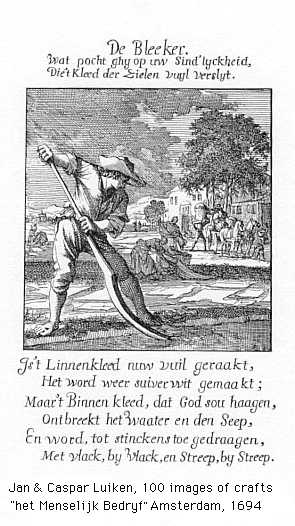Laundry list
 Blackboard
for bookkeeping the linnen garments sent out to wash, 'bordetgen
daer men het linnewaet op teeckent'. On this laundry list the
number of each item sent out to the cleaners was noted. This was
necessary as linen clothes were quite expensive.
Blackboard
for bookkeeping the linnen garments sent out to wash, 'bordetgen
daer men het linnewaet op teeckent'. On this laundry list the
number of each item sent out to the cleaners was noted. This was
necessary as linen clothes were quite expensive.
slaeplake = bed sheet
slope = pillowcase
tafelake = tablecloth
hemde = shirt
neerstick = neck piece, modesty fill-in or partlet
huive = undercap
krage = ruff
beffe = flat collar
neusdoeck = handkerchief
schorteldoeck = apron
sante = a cloth worn on a woman's head for informal
situations with the front back folded back so it shaded the face,
hence called bongrace in English
luire = diaper, child's swaddling cloth
mutse = cap
hulle = coif
flep = triangular cross-cloth or head-band worn over the
hair but under a coif (cap) by children and women when ill or in bed,
worn with the point at the back.
poverette = cuffs
 The
cleaning of bed linnen, table linnen and linen clothes was a labour
intensive craft, which was performed by professional laundries,
having access to clean water and a bleaching field. The costly linnen
was transported in locked baskets and was returned washed, dried,
bleached on a field, ironed and folded.
The
cleaning of bed linnen, table linnen and linen clothes was a labour
intensive craft, which was performed by professional laundries,
having access to clean water and a bleaching field. The costly linnen
was transported in locked baskets and was returned washed, dried,
bleached on a field, ironed and folded.
Smaller batches of laundry were cleaned by the home pump (see
below for the washing kitchen, room J) and afterwards exposed to
light on bleaching fields (Pijzel, Pronkpoppenhuis, 2000, p.
170.)
Note : This object , which shows the shape
of garments, was NOT part of the Vermeer-inventory as listed by the
clerk working for Delft notary public J. van Veen. He made this list
on February 29, 1676, in the Thins/Vermeer home located on Oude
Langendijk on the corner of Molenpoort. The painter Johannes Vermeer
had died there at the end of December 1675. His widow Catherina and
their eleven children still lived there with her mother Maria
Thins.
The transcription of the 1676 inventory, now
in the Delft archives, is based upon its first full publication by
A.J.J.M. van Peer, "Drie collecties..." in Oud Holland 1957,
pp. 98-103. My additions and explanations are added within square
brackets [__]. Dutch terms have been checked against the
world's largest language dictionary, the Dictionary of the Dutch
Language (Woordenboek der Nederlandsche Taal , or WNT),
which was begun by De Vries en Te Winkel in 1882. In 2001 many
textile terms have been kindly explained by art historian Marieke te
Winkel.
Illustration on top taken from the recently
published handbook on Dutch Doll Houses by Jet Pijzel-Dommisse,Het
Hollandse pronkpoppenhuis, Interieur en huishouden in de 17de en 18de
eeuw, Waanders, Zwolle; Rijksmuseum, Amsterdam, 2000, ill.
294.

This page forms part of a large encyclopedic site on Vermeer and Delft. Research by Drs. Kees Kaldenbach (email). A
full presentation is on view at johannesvermeer.info.
Launched December, 2002; Last update March 2, 2017.
Back to the Welcome page: click Welcome.
 Blackboard
for bookkeeping the linnen garments sent out to wash, 'bordetgen
daer men het linnewaet op teeckent'. On this laundry list the
number of each item sent out to the cleaners was noted. This was
necessary as linen clothes were quite expensive.
Blackboard
for bookkeeping the linnen garments sent out to wash, 'bordetgen
daer men het linnewaet op teeckent'. On this laundry list the
number of each item sent out to the cleaners was noted. This was
necessary as linen clothes were quite expensive. The
cleaning of bed linnen, table linnen and linen clothes was a labour
intensive craft, which was performed by professional laundries,
having access to clean water and a bleaching field. The costly linnen
was transported in locked baskets and was returned washed, dried,
bleached on a field, ironed and folded.
The
cleaning of bed linnen, table linnen and linen clothes was a labour
intensive craft, which was performed by professional laundries,
having access to clean water and a bleaching field. The costly linnen
was transported in locked baskets and was returned washed, dried,
bleached on a field, ironed and folded.